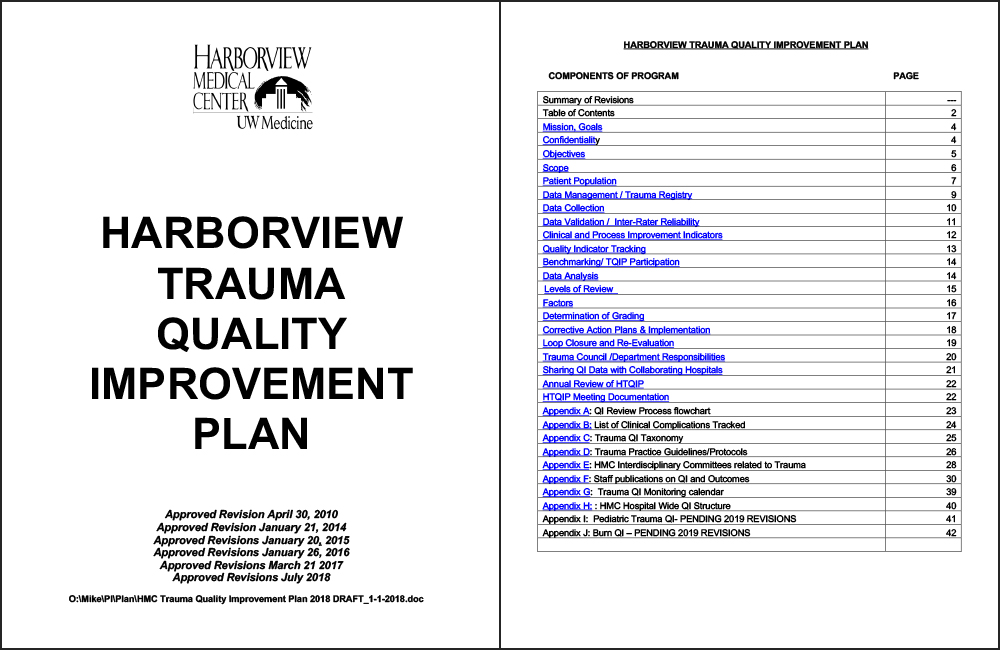
Harborview; Trauma Quality Improvement Plan
MISSION
Harborview Medical Center provides trauma care to adults and children serving as a Level I adult and pediatric trauma center. Harborview is committed to providing the highest level of definitive care for injured patients, from resuscitation through rehabilitation. As the only Level I facility in a four-state region (Washington, Alaska, Montana and Idaho), Harborview participates in a regional system designed to ensure that every injured patient has access to the appropriate level of trauma care as soon as possible.
GOALS
The goals of the trauma quality improvement program at Harborview Medical Center are:
- To provide a method of peer review oversight and evaluation of all aspects of adult and pediatric trauma care from pre-hospital care to rehabilitation.
- To assist in providing the highest level of care and service to trauma patients, their families, pre-hospital agencies, referring providers and medical centers in the region. This includes peer review and feedback for care provided across the continuum of the trauma system.
- To design, measure, assess and improve patient care processes and triage of adult and pediatric trauma care within the system.
- To measure, assess and improve patient outcomes following traumatic injury. This includes establishing and implementing evidence-based guidelines for trauma care.
- To evaluate and improve satisfaction of patients, patient families, staff, community, and licensing and accrediting agencies with the quality of trauma care at Harborview Medical Center.
- To provide a forum that encourages presentation of errors or potential errors that is protected from legal disclosure, that is available to all health care providers, with the goal of system improvement rather than blame assignment.
- The trauma Quality Improvement plan provides a mechanism for implementing these goals within the broader context of the hospital-wide Quality Improvement program and seeks to integrate with hospital Quality Improvement initiatives.
OBJECTIVES
- Integrate and coordinate all trauma quality and performance improvement activities under the direction of the multidisciplinary Trauma Council, the Chief of Trauma Surgery and the Medical Director of Emergency Services.
- Ensure that confidentiality of patient and provider information is maintained according to the standards of RCW 70.41.200 and 70.168.090
- Provide feedback to prehospital EMS and air medical services and referring hospitals regarding patient care issues during transfer and transport.
- Evaluate specific cases or problems identified in the monitoring process by peer review, through Departmental Mortality and Morbidity conferences, the multidisciplinary Trauma Council and provide an educational forum (Trauma Conference) for wide-spread dissemination of practice guidelines.
- Use results from internal and external data collection measurement activities (e.g. audit filters) to study and improve processes and outcomes.
- Develop standards of quality care for both adult and pediatric trauma.
- Provide a process to monitor compliance with or adherence to the standards.
- Provide processes for loop closure in correcting problems or deficiencies and measuring the effectiveness of corrective actions.
- Identify, evaluate and impact pediatric Quality Improvement issues through the Harborview Pediatric Council.
- Identify, and evaluate transitional and long-term outcomes of trauma care through the Harborview Rehab Council for adult trauma care and through the coordinated activities of the Harborview Pediatric Council and Seattle Children’s Hospital for pediatric care.
- Use comparative data to benchmark performance of adult and pediatric trauma care to that of other Level 1 trauma centers.
- Identify, evaluate and impact regional quality assurance issues through the Regional Trauma Quality Assurance Committees.
- Partner with the Washington State Department of Health and EMS and Trauma Steering committee to implement evidence-based guidelines for trauma care statewide and evaluate system effectiveness and efficiency
SCOPE
- The trauma Quality Improvement program applies to evaluation across the continuum from pre-hospital care to rehabilitation and re-integration of the patient into their community. The Quality Improvement program is applied to the full scope of trauma service including Prehospital care, resuscitation and evaluation, operative interventions, intensive care, short-term acute care and long-term/transitional care for adult trauma patients.
- For pediatric trauma patients, Harborview is equipped to provide all resuscitation and evaluation, operative interventions, intensive care and short-term acute care services. In some cases, children require highly specific pediatric sub-specialty care, long-term/transitional care or pediatric inpatient rehabilitation services. For these patients, care is transferred to Seattle Children’s Hospital (SCH). The Quality Improvement program applies both to the initial resuscitation and acute phases of pediatric trauma care, as well as the long-term/transitional care through coordinated quality and performance improvement evaluations with SCH.
- As the sole Level 1 trauma center for the region the scope of this QI program extends to the regional trauma system where we provide feedback to referring hospitals and serve as a resource for development of statewide patient care guidelines and assistance with QI initiatives and education across the region.
Specifications
- Last Updated: 2018
- Author(s): Harborview Medical Center
- Category: Performance Improvement
- Tags: 2018, English, Harborview Medical Center
Word Documents
Please login to access file downloads.
PDF Documents
Please login to access file downloads.
